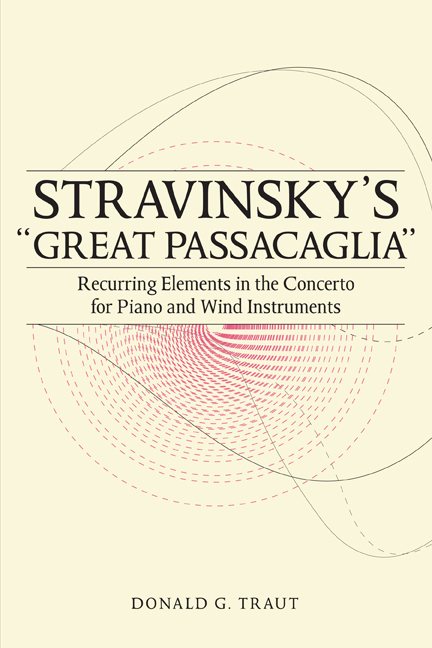Book contents
- Frontmatter
- Dedication
- Contents
- Acknowledgments
- Introduction
- 1 Context and Composition
- 2 Concerto as Catalyst
- 3 Analytical Tools and Recurring Elements
- 4 Counterpoint and Tonality in the First Movement
- 5 Tetrachords and Tritones in the Largo
- 6 Points of Imitation in the Finale
- Conclusion
- Appendix
- Notes
- Bibliography
- Index
3 - Analytical Tools and Recurring Elements
Published online by Cambridge University Press: 12 August 2020
- Frontmatter
- Dedication
- Contents
- Acknowledgments
- Introduction
- 1 Context and Composition
- 2 Concerto as Catalyst
- 3 Analytical Tools and Recurring Elements
- 4 Counterpoint and Tonality in the First Movement
- 5 Tetrachords and Tritones in the Largo
- 6 Points of Imitation in the Finale
- Conclusion
- Appendix
- Notes
- Bibliography
- Index
Summary
This chapter is in two parts. Part 1 identifies several hallmarks of Stravinsky's neoclassic music and addresses how scholars grapple with them. Five pairs of topics subdivide this section and reflect the unique challenges Stravinsky analysis often presents. In many cases, the pairings represent closely related concepts that nonetheless require individual attention. Stravinsky was a master at melding overt references to established musical conventions with his own new twists on those conventions. The results leave analysts searching for ways to represent the new elements, but reluctant simply to abandon conventional analytic tools. Therefore, it is important to discuss such distinctions as tonality versus centricity, linear progressions versus associational relationships, referential versus octatonic collections, contrapuntal versus metric displacement, and borrowing versus quotation. Part 2 applies a range of analytical tools to the Concerto's opening measures. Specifically, it relates these measures to the calendar sketch page seen earlier (fig. 1.1), on which Stravinsky scratched out some basic ideas for the piece. What emerges is a set of four recurring motivic figures that bind the piece together and set the stage for subsequent analyses.
Part 1. Hallmarks of Stravinsky's Neoclassicism
Centricity and Tonality
Stravinsky's neoclassic music frequently features a clear tonal center. Regardless of the source (i.e., diatonic, octatonic, serial) or complexity of the surface pitch formations, he most often composed hierarchically. Even the serial works of his last period exhibit this trait. In the neoclassic pieces, he sometimes drew attention to it by citing the centric pitch class in the title. By giving pieces titles such as Sérénade en la and Symphony in C, he invites us to hear them from a tonal perspective. But of course, it is never that simple with Stravinsky. In discussing tonality in a piece like the Concerto, several questions crop up. Is the music “in” A? Or is it simply “on” A? What is the distinction between the two? Stravinsky himself referred to the piece informally as “the Concerto en la,” but what exactly does that mean? Clearly not the same thing that it would have in earlier eras. Besides, only the first movement begins and ends “in” (or “on”) A; both the Largo and the finale center more around C.
- Type
- Chapter
- Information
- Stravinsky s "Great Passacaglia"Recurring Elements in the Concerto for Piano and Wind Instruments, pp. 51 - 66Publisher: Boydell & BrewerPrint publication year: 2016



